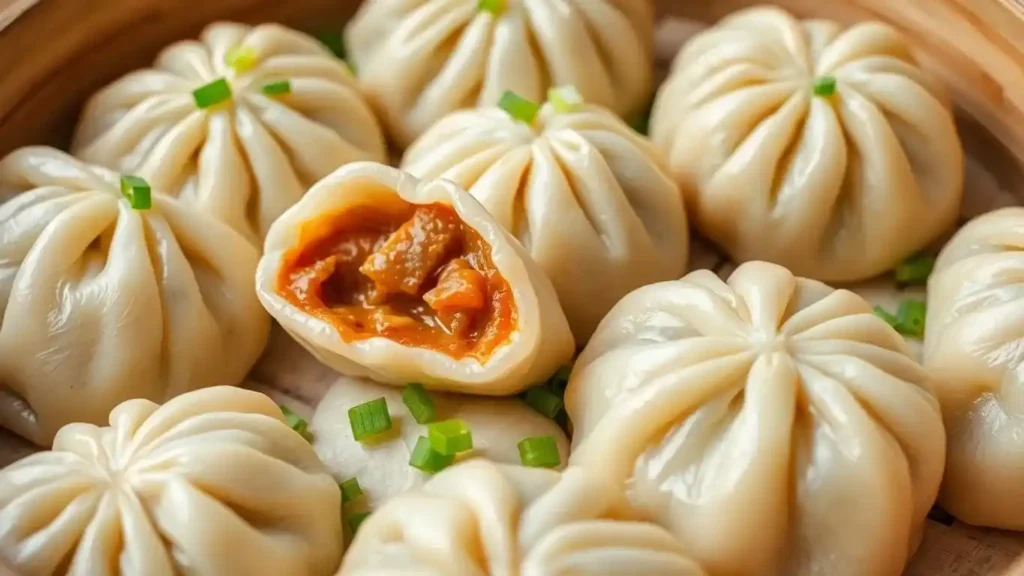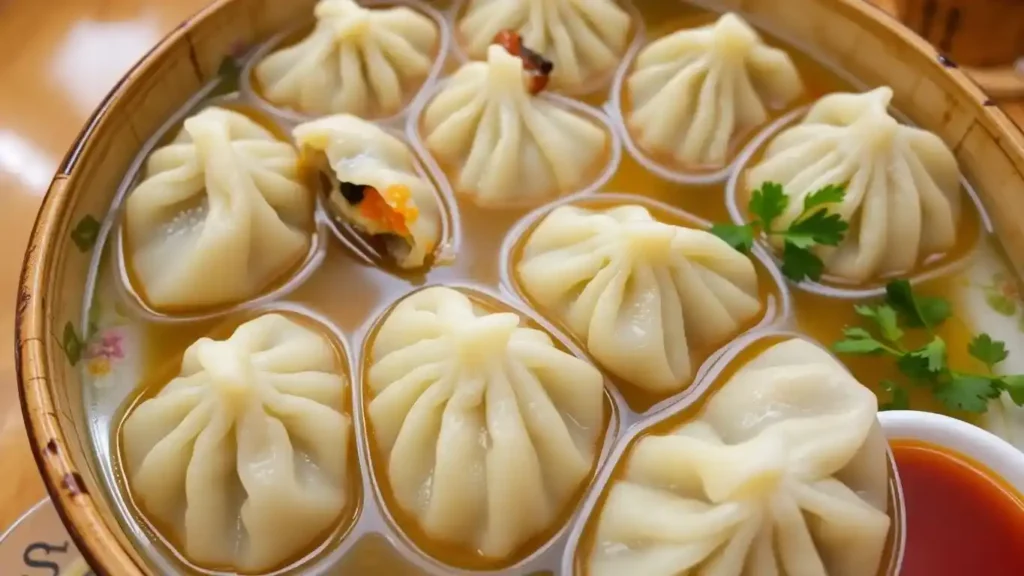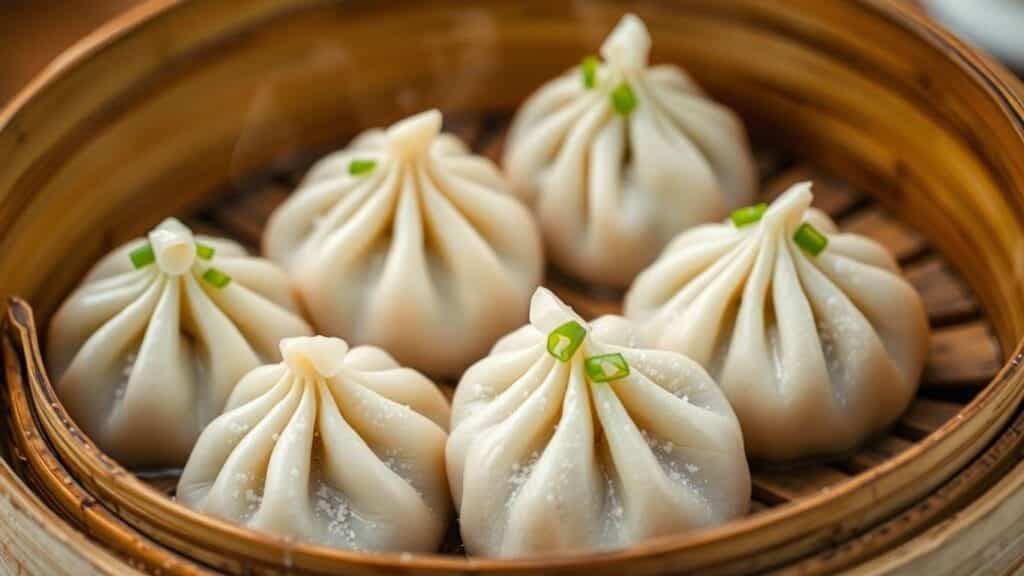Ever wondered how gelatin in soup dumplings creates that signature soupy bite? Traditional Xiao Long Bao uses gelatin to solidify broth before steaming, allowing it to melt back into liquid inside the dumpling.
But what if you’re looking for vegetarian-friendly alternatives? Finding a substitute for gelatin in soup dumplings can be tricky, as the replacement must hold its shape when chilled but melt when steamed.
This guide explores how gelatin works in soup dumplings, why it’s essential, and the best plant-based substitutes for gelatin in soup dumplings so you can make delicious dumplings at home.
What You’ll Learn in This Guide
- How gelatin works in traditional soup dumplings
- The best vegetarian alternatives to gelatin
- Step-by-step method for making soup dumplings with agar-agar
- Tips for preventing leaks and ensuring the perfect texture
Key Takeaways
- Agar agar is a popular vegetarian substitute for gelatin in soup dumplings.
- Carrageenan can also be used for a gelatin-like consistency.
- Vegetable broth can replace traditional meat-based broths in vegetarian dumplings.
- Using agar agar requires precise measurement for the right texture.
- Freezing the dumplings can help maintain their shape and prevent leakage.
Table of Contents
Understanding the Role of Gelatin in Soup Dumplings

To create the perfect soup dumpling (Xiao Long Bao), the broth must transform into a solid gel when cooled and then melt into a flavorful soup when steamed. Traditional recipes use gelatin, which plays a crucial role in this transformation.
How Gelatin Works in Soup Dumplings Creates the Soup Effect
The key to gelatin in soup dumplings is its ability to solidify broth when cooled and melt into soup when steamed. Traditional recipes use gelatin in soup dumplings to lock in the liquid and create the signature broth-filled bite. However, if you prefer a plant-based option, choosing the right gelatin substitute for soup dumplings is essential to maintain the same effect.
Traditional Ingredients for Gelatinous Broth
Classic soup dumplings rely on slow-simmered bone broths that naturally contain gelatin. Here’s how they’re traditionally made:
- Beef bones or skin – High in collagen, which solidifies when cooled.
- Chicken feet – A rich source of gelatin, commonly used in soup dumplings.
- Aromatics (ginger, scallions, garlic) – Enhance the depth of flavor in the broth.
Once the broth is chilled, it solidifies into a gel-like consistency, making it easy to cut into small cubes and mix with the dumpling filling.
Challenges of Using Gelatin in Dumplings
Using traditional gelatin-based broth has some challenges:
- Requires long cooking times – Bone broth can take several hours to extract sufficient collagen.
- Needs proper chilling – If the broth isn’t cooled completely, it won’t set into a solid gel.
- Store-bought gelatin may contain additives – Some pre-packaged gelatin has stabilizers that can alter taste and texture.
While gelatin is a reliable option, it’s not suitable for vegetarians and vegans, which is why we need plant-based alternatives that work similarly.
Exploring Vegetarian Alternatives to Gelatin
For those seeking a vegetarian or vegan-friendly way to make soup dumplings, there are several plant-based gelling agents that work as substitutes for gelatin. These alternatives provide the same solid-to-liquid transformation needed for the dumpling’s signature soup effect.
Agar-Agar: The Best Gelatin Substitute for Soup Dumplings
Agar-agar is one of the most popular vegetarian substitutes for gelatin. Derived from red algae (seaweed), it forms a firm gel when cooled but melts when exposed to heat making it perfect for steamed dumplings.
Looking for a completely plant-based version? Check out these Vegan Soup Dumplings: A Delicious Plant-Based Twist.
Why Agar-Agar Works Well in Soup Dumplings
- 100% Plant-Based – Suitable for vegetarians and vegans.
- Holds its Shape Well – Sets more firmly than gelatin, preventing leakage.
- High-Heat Stability – Maintains its structure even at boiling temperatures.
How to Use Agar-Agar in Soup Dumplings
- Simmer your vegetable broth with 1 teaspoon of agar-agar powder per 1 cup of liquid.
- Whisk continuously until fully dissolved.
- Pour into a shallow dish and let it cool at room temperature, then refrigerate until firm.
- Once set, cut into small cubes and mix with the dumpling filling.
Agar-agar sets more firmly than gelatin, so it’s important to use the right ratio. If the gel is too hard, slightly reduce the amount of agar in your next batch.
Agar-agar is commonly used in plant-based recipes, like these Vegan Soup Dumplings, which swap out traditional gelatin for a vegetarian-friendly alternative.
Using Carrageenan for Soup Dumplings
Carrageenan is another seaweed-derived thickener, but it has a softer, more elastic texture compared to agar-agar. It’s commonly used in dairy alternatives and can work well in soup dumplings for those who prefer a less firm gel.
Best Uses for Carrageenan in Soup Dumplings
- Creates a creamier, softer gel that melts faster.
- Great for dumplings that need a quicker release of broth.
- Works best when combined with a little starch to maintain the right consistency.
To use carrageenan, simply dissolve it in hot broth, chill it, and let it set before cutting into cubes.
Other Plant-Based Gelling Agents to Try
In addition to agar-agar and carrageenan, there are a few more plant-based options worth experimenting with:
| Gelling Agent | Texture | Best Used For |
|---|---|---|
| Konjac Powder | Firm & bouncy | Great for a more elastic gel |
| Pectin | Soft & jelly-like | Can be used for a slightly looser soup effect |
| Guar Gum | Thickening, not a full gel | Best for stabilizing broth in fillings |
Each of these alternatives has different gelling properties, so you may need to adjust ratios and test different combinations to find what works best for your dumpling filling.
Experimenting with Vegetarian Soup Dumpling Fillings
Once you’ve chosen your gelatin substitute, you can enhance the dumplings’ flavor with plant-based broth and ingredients:
✔ Use vegetable broth infused with mushrooms, ginger, and garlic for umami depth.
✔ Combine agar-agar cubes with finely chopped tofu, mushrooms, and bok choy for a balanced filling.
✔ Add a splash of black vinegar before steaming to bring out the dumplings’ flavor.
By using these gelatin substitutes, you can enjoy soup dumplings without animal products, while still getting the rich, flavorful soup effect.
Making Soup Dumplings with Agar-Agar
Now that we’ve explored the best vegetarian gelatin substitutes, let’s walk through the step-by-step process of making soup dumplings using agar-agar. This method ensures you get the signature soupy filling while keeping the dumplings completely plant-based.
Preparing the Agar-Agar Soup Base
The first step is to create a gelled broth that will melt into soup inside the dumplings when steamed.
Ingredients for the Broth Gel
✔ 2 cups vegetable broth (mushroom broth works best for umami flavor)
✔ 1 teaspoon agar-agar powder
✔ ½ teaspoon soy sauce (or tamari for a gluten-free option)
✔ ½ teaspoon sesame oil
✔ ½ teaspoon grated ginger
Step-by-Step Instructions
- Simmer the Broth:
- Heat the vegetable broth in a saucepan over medium heat.
- Add soy sauce, sesame oil, and grated ginger for extra flavor.
- Dissolve the Agar-Agar:
- Sprinkle 1 teaspoon of agar-agar powder into the broth while stirring continuously.
- Simmer for 1-2 minutes until fully dissolved.
- Cool and Set:
- Pour the mixture into a shallow dish and let it cool to room temperature.
- Transfer to the refrigerator for 30-40 minutes until firm.
- Cut into Cubes:
- Once set, cut the gel into small cubes about ½ inch in size.
- These cubes will be added to the dumpling filling.
Incorporating the Agar-Agar Gel into the Filling
Now that your gelled broth is ready, it’s time to prepare the dumpling filling.
Ingredients for the Filling
✔ 1 cup shiitake mushrooms, finely chopped
✔ ½ cup firm tofu, crumbled
✔ ½ cup bok choy, finely chopped
✔ 1 clove garlic, minced
✔ 1 teaspoon soy sauce
✔ ½ teaspoon sesame oil
✔ ½ teaspoon white pepper
Mixing the Filling
- Combine all filling ingredients in a large bowl.
- Gently fold in the agar-agar broth cubes to avoid breaking them.
- Mix thoroughly so the broth cubes are evenly distributed.
Assembling the Dumplings
Once the filling is ready, it’s time to wrap the dumplings.
Making the Dumpling Dough
✔ 2 cups all-purpose flour
✔ ¾ cup hot water
- Mix flour and hot water in a bowl until it forms a dough.
- Knead for 8-10 minutes until smooth and elastic.
- Cover and rest for 30 minutes to allow gluten to relax.
Rolling Out Wrappers
- Divide the dough into small portions and roll into thin circles (about 3 inches wide).
- Keep the edges thinner than the center for easy pleating.
Filling and Folding the Dumplings
- Place 1 tablespoon of filling in the center of each wrapper.
- Fold and pleat the edges tightly to seal in the soup.
- Make sure the dumplings are completely sealed to prevent leaks during steaming.
Steaming the Dumplings
- Prepare the Steamer:
- Line a bamboo or metal steamer with parchment paper or cabbage leaves.
- This prevents the dumplings from sticking.
- Arrange the Dumplings:
- Place them in the steamer, leaving space between each dumpling.
- Steam for 10-12 Minutes:
- The dumplings will turn translucent, and the agar-agar will melt into soup.
- Serve Hot:
- Carefully transfer dumplings to a plate.
- Enjoy with a dipping sauce made from soy sauce, rice vinegar, and chili oil.
Tips for Perfect Agar-Agar Soup Dumplings
- Use hot water in the dough to make it more elastic and easier to pleat.
- Keep the broth cubes cold while assembling the dumplings to prevent them from melting.
- Seal the dumplings tightly to avoid broth leakage.
- Steam over high heat to fully liquefy the agar-agar inside the dumplings.
Crafting Flavorful Broths Without Gelatin

A rich and flavorful broth is essential for making vegetarian soup dumplings. Since traditional broths rely on animal bones for depth and collagen, we’ll explore plant-based alternatives that provide the same umami-packed taste without gelatin.
Making a Vegetable Broth for Soup Dumplings
A well-balanced vegetable broth forms the foundation of delicious plant-based soup dumplings.
Key Ingredients for a Rich Broth
✔ 2 carrots, chopped – Adds natural sweetness.
✔ 1 onion, quartered – Brings depth and aroma.
✔ 3 cloves garlic, smashed – Enhances flavor.
✔ 1 cup dried shiitake mushrooms – Essential for umami richness.
✔ 2 tablespoons soy sauce – Adds a savory, salty depth.
✔ 1 teaspoon sesame oil – Enhances aroma.
✔ 1 teaspoon white pepper – Adds a mild heat.
✔ 6 cups cold water
Step-by-Step Instructions
- Simmer the Ingredients:
- In a large pot, add all ingredients and bring to a gentle simmer over medium heat.
- Let it cook uncovered for 1 to 2 hours, allowing the flavors to concentrate.
- Strain the Broth:
- Use a fine-mesh strainer or cheesecloth to remove solids, leaving a clear, flavorful broth.
- Enhance the Flavor (Optional):
- Stir in 1 teaspoon miso paste or a splash of black vinegar for extra depth.
This vegetable-based broth works perfectly with agar-agar, creating a solid gel that melts inside the dumplings when steamed.
Enhancing Broth Flavor with Umami Ingredients
Since vegetarian broths lack animal fat, they need extra umami boosters to replicate the richness of traditional gelatinous broths.
✔ Dried Mushrooms (Shiitake or Porcini): Intensifies the depth of flavor.
✔ Miso Paste: Adds a mild fermented umami taste.
✔ Nutritional Yeast: Gives a subtle cheesy, savory profile.
✔ Kombu (Dried Seaweed): Adds natural glutamates for deeper umami.
✔ Fermented Black Beans: Provides an earthy, bold taste.
Adding one or more of these ingredients will elevate the broth’s complexity and make the dumplings even more flavorful.
Balancing Texture and Taste in the Broth
Once the broth is prepared, you’ll need to thicken it into a gel before making the dumplings.
Choosing the Right Gelling Agent
| Gelling Agent | Texture | Best For |
|---|---|---|
| Agar-Agar | Firm, melts well | Best overall choice |
| Carrageenan | Soft, creamy | Smooth, melt-in-your-mouth feel |
| Konjac Powder | Slightly chewy | Good for firmer texture |
| Pectin | Soft, jelly-like | Light, delicate broths |
If you want a lighter soup effect, use a mix of agar-agar and pectin. If you prefer a firmer gel, stick to pure agar-agar.
Why Gelatin in Soup Dumplings Creates the Signature Broth
- Heat the broth and bring it to a simmer.
- Whisk in 1 teaspoon of agar-agar powder per 2 cups of broth.
- Boil for 1-2 minutes, stirring continuously.
- Pour into a shallow dish and refrigerate for at least 30 minutes until set.
- Cut into small cubes before adding them to the dumpling filling.
This method ensures the broth transforms into soup once steamed inside the dumplings.
Tips for Perfect Soup Dumplings Every Time
Making soup dumplings at home requires precision, but with the right techniques, you can achieve delicate, soup-filled dumplings with the perfect bite. Follow these essential tips to prevent leaks, improve texture, and ensure a smooth cooking process.
Choosing the Right Dough for Dumplings
The wrapper plays a crucial role in holding the soup and filling together. It must be thin yet sturdy enough to prevent tearing.
- Use all-purpose flour – Provides the right balance of elasticity and strength.
- Hot water dough method – Helps create a pliable and stretchable dough.
- Rest the dough for at least 30 minutes – This allows the gluten to relax, making it easier to roll out.
- Roll the dough thin but not too thin – Aim for ⅛ inch (3mm) thickness to prevent leaks.
Pro Tip: If you want extra elasticity, add ½ teaspoon of cornstarch to the flour before mixing in water.
Folding Techniques for Soup Dumplings
Proper pleating ensures that the dumplings hold their shape and don’t leak. The classic Xiao Long Bao (soup dumpling) fold is a circular pleat, sealed at the top.
Step-by-Step Folding Guide
1️⃣ Place a dumpling wrapper on your palm.
2️⃣ Add 1 tablespoon of filling and one cube of agar-agar broth gel.
3️⃣ Pinch and pleat the edges, folding towards the center.
4️⃣ Twist the top slightly to completely seal the dumpling.
- Ensure a tight seal – Any gaps will cause the soup to leak.
- Don’t overfill – Too much filling can weaken the wrapper.
- Work quickly – The warmth from your hands can soften the dough too much.
Practice makes perfect! The more dumplings you fold, the better your technique will become.
Steaming and Serving Suggestions
Steaming brings everything together—melting the broth gel and cooking the filling.
How to Steam Soup Dumplings Correctly
Perfecting the Soup Dumpling Eating Experience
Soup dumplings are best enjoyed hot and fresh, with the right dipping sauce.
- Use a combination of soy sauce, rice vinegar, and chili oil for a tangy, savory dip.
- Pick up a dumpling with chopsticks and place it in a spoon.
- Bite a small hole in the top to let the steam escape before drinking the soup.
- Then, enjoy the entire dumpling in one bite for the full flavor experience!
Common Mistakes When Using Gelatin in Soup Dumplings
Even experienced cooks can run into issues when making soup dumplings. Avoiding these common mistakes will help you achieve dumplings that are perfectly filled, well-sealed, and leak-free.
Overcoming Gelatin Substitution Challenges
Switching gelatin for agar-agar or other plant-based alternatives can be tricky. These substitutes behave differently, so understanding their properties is key.
- Agar-Agar Needs Boiling – Unlike gelatin, agar-agar must be boiled for 1-2 minutes to activate its gelling properties.
- Use the Right Ratio – Agar-agar sets firmer than gelatin, so using too much can result in a rubbery texture. The ideal ratio is 1 teaspoon of agar-agar per 2 cups of broth.
- Let the Broth Cool Properly – Rushing the cooling process may cause an uneven gel that won’t hold its shape.
Pro Tip: If your agar-agar gel turns out too firm, reduce the amount of agar-agar in the next batch.
Preventing Dumpling Leakage
A leaky dumpling means all the soup escapes, leaving you with a dry filling instead of the burst of broth you expect.
How to Prevent Leaks in Soup Dumplings
- Seal the Edges Tightly – Press the dough firmly together and pinch each pleat well to avoid gaps.
- Don’t Overfill – Adding too much broth gel or filling increases the risk of tearing the dough.
- Check Dough Thickness – If the wrapper is too thin, it may tear during steaming. Aim for ⅛ inch (3mm) thickness.
- Avoid Wet Fillings – Excess moisture from vegetables (like zucchini or spinach) can weaken the dough. Squeeze out excess water before mixing.
Avoiding Dough Sogginess
No one likes a soggy dumpling! Proper steaming and handling techniques help maintain the perfect texture.
- Use a Bamboo Steamer – Bamboo steamers absorb moisture and help prevent excess condensation from dripping onto the dumplings.
- Line the Steamer with Cabbage or Parchment Paper – This prevents dumplings from sticking while also absorbing excess moisture.
- Steam Over High Heat – Low heat can cause dumplings to cook unevenly, making them gummy instead of delicate.
- Don’t Let Dumplings Sit Too Long After Steaming – Serve immediately to maintain texture.
Mastering the Right Folding and Steaming Process
If dumplings fall apart while cooking, they may have been improperly folded or pleated.
- Practice the Pleating Technique – Well-folded dumplings hold their shape better and resist leaks.
- Don’t Stretch the Dough Too Thin – Overly thin wrappers can break under pressure during steaming.
- Steam Immediately After Folding – If dumplings sit too long, they may absorb moisture and become too soft before cooking.
Freezing and Storing Dumplings with Gelatin in Soup Dumplings

If you want to make soup dumplings ahead of time or store leftovers, proper storage and reheating are essential to maintain their delicate texture and juicy filling. Here’s how to keep them fresh and flavorful.
How to Freeze Soup Dumplings Properly
Soup dumplings freeze well, making them a great meal prep option. However, if not stored correctly, they can stick together or lose their soup filling.
Step-by-Step Freezing Instructions
1️⃣ Arrange the dumplings in a single layer on a parchment-lined tray. Make sure they don’t touch, or they’ll stick together.
2️⃣ Place the tray in the freezer for 1-2 hours until the dumplings are firm.
3️⃣ Transfer frozen dumplings to an airtight container or a freezer-safe ziplock bag.
4️⃣ Label the container with the date – Dumplings stay fresh in the freezer for up to 3 months.
- Never freeze uncooked dumplings in a pile – they will stick together and break when steamed.
- Avoid using too much flour on the wrappers before freezing – it can make them gummy when reheated.
Reheating Frozen Soup Dumplings Without Losing Flavor
When it’s time to enjoy your dumplings, steaming is the best reheating method to keep them juicy and delicate.
How to Steam Frozen Dumplings
1️⃣ Do NOT thaw – Steam dumplings straight from frozen.
2️⃣ Line the steamer with parchment paper or cabbage leaves to prevent sticking.
3️⃣ Steam over boiling water for 12-15 minutes until the dumplings turn translucent.
4️⃣ Serve immediately with your favorite dipping sauce.
- Avoid microwaving – It can make the dough rubbery and dry out the soup inside.
- Check for doneness – The dumplings should be hot throughout, with fully melted broth inside.
Refrigerating and Reheating Leftover Cooked Dumplings
If you have already steamed dumplings and want to store leftovers, follow these steps:
How to Store Cooked Dumplings
- Let them cool completely before storing – This prevents condensation from making them soggy.
- Place them in an airtight container in the refrigerator.
- Consume within 2 days for the best texture and flavor.
How to Reheat Cooked Dumplings
1️⃣ Steam over boiling water for 5-7 minutes until heated through.
2️⃣ Alternatively, pan-fry leftover dumplings with a little oil to create crispy-bottom soup dumplings.
✔ Never microwave cooked soup dumplings – This will cause the wrappers to dry out and turn chewy.
Conclusion
So, there you have it! Gelatin in soup dumplings plays a crucial role in creating that burst of flavorful broth. However, if you prefer a vegetarian option, agar-agar is the best substitute for gelatin in soup dumplings.
By mastering the right gelatin alternative in soup dumplings, you can perfect the balance of a delicate wrapper, flavorful filling, and delicious soupy interior. Whether using traditional gelatin in soup dumplings or experimenting with plant-based alternatives, your dumplings will be bursting with flavor!
Frequently Asked Questions
What is the purpose of gelatin in soup dumplings?
Gelatin in soup dumplings is used to turn broth into a solid gel before wrapping it in dough. When steamed, the gelatin melts into a soup, giving dumplings their signature juicy bite.
What is the best substitute for gelatin in soup dumplings?
If you want a plant-based substitute for gelatin in soup dumplings, the best options include agar-agar, carrageenan, and konjac powder.
How can I ensure gelatin in soup dumplings melts properly?
To prevent issues, ensure gelatin in soup dumplings is fully dissolved in hot broth before setting. The gel-to-liquid transformation happens at 140°F (60°C) when steaming.
What should I do if my dumplings leak during steaming?
If your dumplings leak during steaming, it might be due to improper sealing or thin dough. Make sure to pinch the edges of the dough tightly and use a dough thickness that can hold the filling without tearing.
